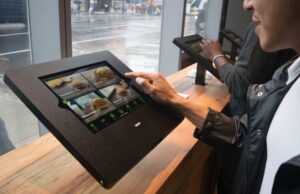
Self-ordering kiosks are quickly becoming a vital tool for the food service industry, especially in the Philippines. These innovative systems allow customers to place their own orders using touchscreen kiosks, without the need for direct interaction with staff. The self-ordering kiosk technology not only improves the customer experience but also helps streamline restaurant operations, reduce errors, and increase efficiency. As the demand for quick, contactless, and seamless service grows, businesses in the Philippines are discovering the advantages of integrating these kiosks into their establishments. This article explores the benefits of self-ordering kiosks and why they’re reshaping the dining experience in the Philippines.
Understanding the Self-Ordering Kiosk Concept in the Philippines
A self-ordering kiosk is an interactive, touchscreen device that allows customers to browse a menu, select food or beverages, customize orders, and make payments—all without the assistance of a human server. These kiosks are typically placed in restaurants, fast-food chains, and food courts to streamline the ordering process. In the Philippines, where convenience and efficiency are highly valued, self-ordering kiosks have become a popular choice for restaurants aiming to meet the needs of tech-savvy and time-conscious customers.
The concept of a self-ordering kiosk Philippines is gaining traction as more consumers seek out faster, more personalized dining experiences. With the ability to easily customize orders, customers can choose from a variety of options, from meal preferences to special dietary requirements, all while reducing the chance of errors. Additionally, many kiosks are equipped with integrated payment systems, allowing customers to pay directly at the kiosk using credit or debit cards, QR codes, or mobile wallets.
This self-service model is especially valuable in the context of the Philippines’ bustling food scene, where restaurants are often dealing with high volumes of customers, especially during peak hours. The introduction of self-ordering kiosks helps businesses handle these surges more efficiently, reducing wait times and ensuring smoother operations.
Key Advantages of Self-Ordering Kiosks in Filipino Restaurants
Enhanced Customer Experience
One of the most significant benefits of self-ordering kiosks Philippines is the enhanced customer experience. The simplicity and speed of ordering through kiosks allow diners to place their orders without the need to wait for a server. This quick ordering process is especially important during busy meal periods when long wait times can lead to frustration.
Moreover, kiosks provide customers with the ability to browse the menu at their own pace, take their time with selections, and make modifications to their order, all without the pressure of feeling rushed by a server. Whether it’s adjusting portion sizes, adding toppings, or customizing a dish to suit dietary restrictions, the kiosk allows for a personalized and stress-free ordering process.
For many consumers, the ability to interact with technology also adds an element of fun and novelty. As more restaurants in the Philippines adopt this technology, customers are increasingly expecting it, making it a competitive advantage for businesses that embrace it.
Improved Operational Efficiency
Self-ordering kiosks streamline the entire process of order management, leading to increased operational efficiency. Once a customer places their order on the kiosk, it is immediately routed to the kitchen for preparation via an integrated kitchen display system (KDS). This eliminates the need for servers to manually input orders into the system, reducing the chances of human error and miscommunication.
This real-time communication between the front-end kiosks and the back-end kitchen system allows kitchen staff to prioritize orders, monitor cooking times, and ensure timely preparation. It helps ensure that customers receive their meals faster, which is particularly beneficial during peak hours when restaurants are experiencing a higher volume of orders.
Additionally, with self-ordering kiosks Philippines, businesses can collect and analyze data on customer preferences, popular menu items, and peak ordering times. This data can be used to optimize the menu, predict demand, and improve inventory management.
Increased Order Volume
Self-ordering kiosks can play a crucial role in helping restaurants increase order volume. The streamlined process enables restaurants to handle more orders in a shorter amount of time, especially during rush hours. Since customers are placing their own orders, there is less need for staff to attend to each individual, allowing servers to focus on other important tasks, such as delivering food or managing customer concerns.
Additionally, self-ordering kiosks often have built-in upsell features, where customers are encouraged to add items to their order, such as drinks, sides, or desserts. These upsell opportunities can increase the average check size, helping restaurants boost revenue. Kiosks also make it easier for customers to explore the full menu, which can lead to increased sales of less-ordered items that may otherwise be overlooked.
Technology Behind Self-Ordering Kiosks
The technology behind self-ordering kiosks Philippines is what makes them so efficient and reliable. Most kiosks are equipped with high-resolution touchscreens that allow customers to easily navigate through menus, view images of dishes, and select their preferred options. These systems are integrated with the restaurant’s POS (Point of Sale) system, ensuring that all orders are processed seamlessly.
Once an order is placed, the kiosk system routes it directly to the Kitchen Display System (KDS), a digital interface in the kitchen that replaces the traditional paper ticket system. The KDS displays orders in real-time, allowing kitchen staff to prioritize and prepare meals based on order time and complexity. The system also includes timers to track cooking durations, ensuring that dishes are prepared efficiently and accurately.
Many kiosks are also equipped with contactless payment systems, allowing customers to complete their transaction without physically interacting with a cashier. With mobile payment options becoming increasingly popular in the Philippines, this feature is particularly appealing to tech-savvy customers looking for a quick, secure, and hassle-free way to pay for their meals.
Self-Ordering Kiosks and COVID-19: A Safe Alternative
The COVID-19 pandemic has accelerated the need for contactless solutions in the food service industry. Self-ordering kiosks Philippines have proven to be an effective way to reduce physical contact between customers and staff. By allowing customers to place orders directly at the kiosk and pay electronically, these systems reduce the need for interaction, which is essential for maintaining safety protocols.
Furthermore, many self-ordering kiosks feature sanitization features, such as antimicrobial coatings on screens and automatic cleaning cycles. This ensures that the kiosks remain hygienic and safe for use by multiple customers throughout the day. These safety measures help restaurants maintain customer trust and meet health and safety guidelines.
Challenges and Considerations When Implementing Self-Ordering Kiosks
While the benefits of self-ordering kiosks Philippines are clear, there are also some challenges and considerations to keep in mind when implementing them. The initial investment cost for purchasing and installing kiosks can be substantial, particularly for small or independent restaurants. Additionally, integrating the kiosks with the restaurant’s existing systems, such as the POS and KDS, may require additional technical support and time.
Staff training is another important consideration. While kiosks can reduce the need for servers to take orders, employees will still need to be trained to assist customers with any technical difficulties and ensure that the system runs smoothly. Moreover, some customers, particularly older individuals or those unfamiliar with technology, may require assistance when using the kiosks.
Finally, customer adoption can be a challenge. While younger generations are often more comfortable with self-service technology, some customers may be hesitant or resistant to using kiosks. Restaurants must consider how to make the transition to self-ordering kiosks as smooth as possible for all customers.
The Future of Self-Ordering Kiosks in the Philippines
As technology continues to evolve, the future of self-ordering kiosks Philippines looks promising. Advancements in artificial intelligence, machine learning, and mobile app integration could take the self-ordering experience to the next level. For example, kiosks may soon be able to recognize customer preferences based on past orders, making personalized recommendations to improve the dining experience.
Additionally, multi-language support is likely to become a more common feature, allowing restaurants to cater to the diverse population of the Philippines. With the increasing demand for convenience and speed, self-ordering kiosks are poised to remain an integral part of the Filipino dining scene for years to come.
FAQs
1. What are the benefits of self-ordering kiosks in Filipino restaurants? Self-ordering kiosks improve customer service by reducing wait times and allowing customers to place orders at their own pace. They also streamline operations by minimizing order errors and integrating with the kitchen display system for faster meal preparation.
2. How does a self-ordering kiosk work? Customers can browse menus, customize their orders, and pay using a touchscreen interface. The order is sent directly to the kitchen via a Kitchen Display System (KDS), and the customer receives their order once it’s prepared.
3. Are self-ordering kiosks difficult for customers to use? No, self-ordering kiosks are designed to be user-friendly, with simple navigation and clear instructions. However, some customers may require assistance when using the system for the first time.
4. Do self-ordering kiosks improve restaurant efficiency? Yes, they reduce the likelihood of errors, speed up the ordering process, and help manage high volumes of customers during peak hours, ultimately improving the efficiency of restaurant operations.
5. Are there any hidden costs when implementing a self-ordering kiosk system? While the initial setup cost can be high, there are no hidden costs. However, ongoing maintenance, software updates, and staff training should be factored into the total investment.


